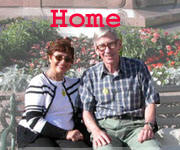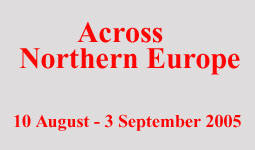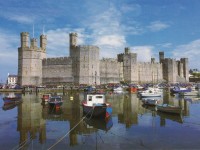Part IV - Page 15 16 16a 17 18 19 Go to: Part I Part II Part III
Tuesday, 30 August (continued). We checked out of the Castlebank at 11:;00 and made the 25-mile drive to Caernarfon. The Caer Menai B&B (built as a school in 1894) where we were staying was inside the city wall just a block and a half from the Caernarfon Castle. We found it easily enough but couldn’t find any place to park. The B&B owner was kind enough to move his car so we could park. Even so, we were checked in by noon. After unloading the car, we walked directly to the Castle. By then it was 12:30. There was a tour scheduled for 1:00, so we waited where it was supposed to start. There were at least a dozen others waiting with us. When I inquired about 1:10, we were told that the guide had cancelled that tour because there wasn’t anyone there for it. So we decided to tour the Castle on our own. The Castle was begun by Edward I in 1283 as part of his “Iron Ring” of fortresses as the English sought to subdue the Welsh. The site contained a Norman fort (1090) and before that had been site of the Roman fort of Segontium (77-394A.D.). King Edward's son (later Edward II) became the first English Prince of Wales in 1301. His investiture, and most subsequent ones, have taken place in London before Parliament. However, Prince Edward (Edward VIII) was invested as Prince of Wales at Caernarfon in 1911, as was Prince Charles in 1969. One of the towers contained an extensive display of photographs and memorabilia from the 1969 investiture.
We climbed the spiral stairs in a couple of the towers and walked along the top of the walls. I left Jane for a bit to climb to the top of the highest tower. There was a great view out over Caernarfon Bay as well as of the castle itself..
We left the Castle about 2:00 and had a light lunch at a sandwich shop nearby. Then we took the self-guided walking tour of the walled city. It took us up and down nearly every street inside the walls. Compared to the age of the Castle, though, the other buildings were quite “new.” The oldest was a recently renovated building on Palace Street parts of which dated from the 15th century. Market Hall (1832), once a fish and produce market, now features mostly tourist goods. There was a street aptly named Hole-in-the-Wall Street because part of the old wall had been knocked down at that point to facilitate modern traffic.
Our tour eventually took us to St. Mary’s Church, built right into the city wall. Most of this 14th century (about 1316) building is intact, although renovations were made in the early 19th century. Unfortunately, the doors were locked so we couldn’t get the inside.
The church was just a block from our B&B, on the same street (Church Street, of course). Jane was getting tired so we went back to the Caer Menai to take a tea break. It was about 3:15.
We resumed our tour at 4:45, following the promenade just outside the city wall and along the water. Before long we came to the Castle wall. The Castle sits near the water’s edge, but there was a small bridge across to the opposite bank We took that and found a magnificent view of the Castle across the water. We also discovered (when it swung) that the span we’d crossed was a “swing bridge” that turns 90 degrees to allow small boats to use the channel.
We got back to the B&B about 5:30 and spent some time in the parlor reading about Wales. At 7:00 we walked to the Black Boy Inn for dinner. We had picked it out during our self-guided tour in the afternoon. The inn dates from 1522 and has load-bearing walls more than four feet thick. We ate in a room with low ceilings, thick wooden support beams, stone walls, and a huge fireplace. Up to this point, we had been avoiding having England’s traditional fish and chips, but we succumbed to a close cousin here, deep fried cod with boiled new potatoes and “mushy peas.” It was very good.
After dinner we walked around to see the town at night. The Castle and parts of the walls were illuminated, but the town was very quiet. We got back to our room about 8:30.
Part IV - Page 15 16 16a 17 18 19 Go to: Part I Part II Part III |





















